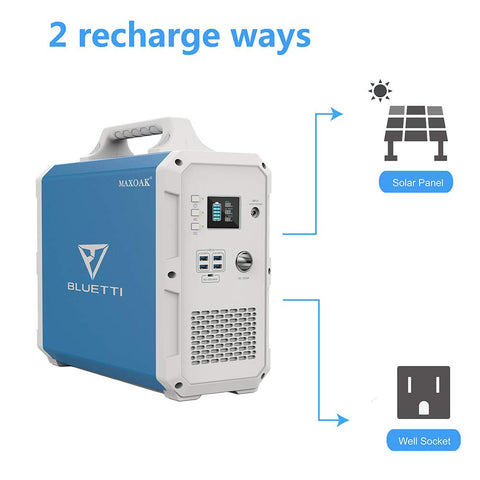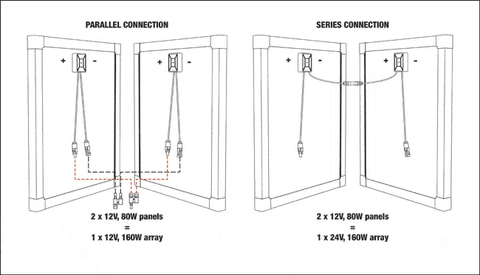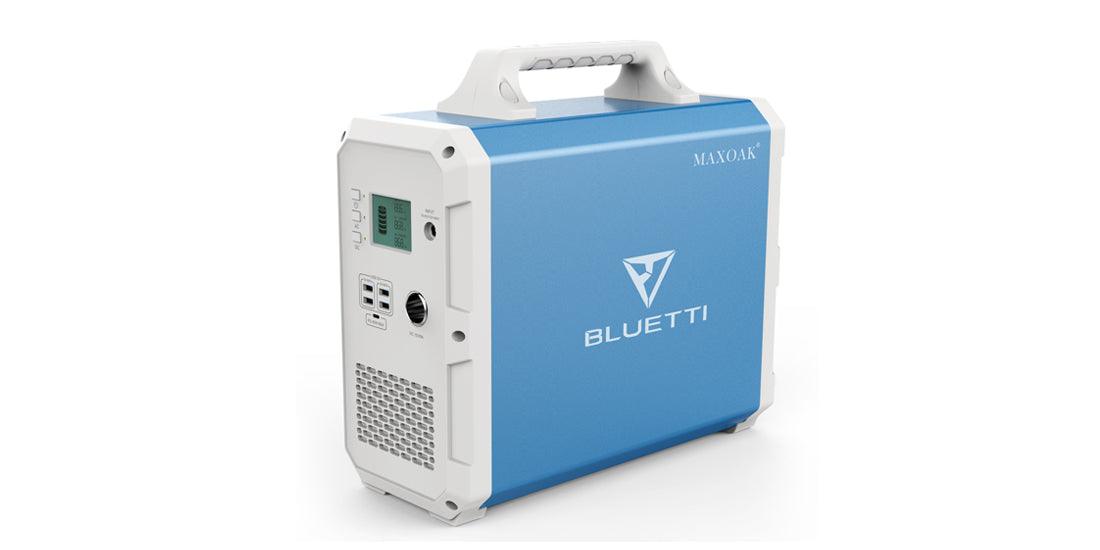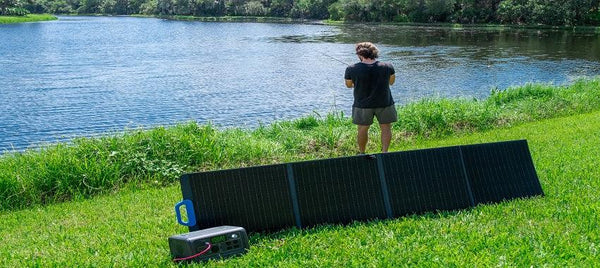There’s a new solar generator that has come out that has caught my eye. It’s doing as well or better than most well-known solar generators on the market. It’s called the “Bluetti” made by MAXOAK.
Testing it has been fun and I have been pretty blown away by how well it works. I have used MAXOAK items in the past and they have always worked well. The Bluetti is right up there with the Goal Zero Lithium 1000 as well as the Inergy Apex and Kodiak (Kodiak no longer in production).
Battery Capacity

The Bluetti boasts a surprising 1,500wh lithium ion battery. That’s a really good size battery for what most people need to run during power outages. I always like to look at solar generators from the standpoint of a power outage because that’s when I use mine the most. I always find ways to use my solar generators for little things here and there, but a power outage is when I truly need it to work and work hard for me.
The most common items to run during a power outage are fridge, freezer, laptops/computers, fans, lights, and microwaves. Of course, there are plenty of other things that people run but these I have found to be the most consistent things people run during power outages. So, the question is can the Bluetti run all of those things? For the most part yes.
Running all of those items except for the microwave are easily doable for the Bluetti. The only way to run a microwave from the Bluetti would be to get a smaller or “weaker” microwave when it comes to power draw. I personally also like to use my toaster oven as well an electric cooktop off my solar generators. Being able to run all 3 of these items (not at the same time) is a true test to me that it’s a solid solar generator. Simply because a solar generator should be able to do the light work and some of the hard work, like running small cooking appliances.
1,500wh battery is generally enough power to run necessary items and still have enough power at the end of the day to get through the night and chargeback up the next day.

Fully Equipped Bluetti Kit Setup
1 Bluetti
4 100w Solar Panels
1 Set 70ft 12 AWG Panel Cables
1 Set 2-Way Cable Branch Connectors
2 Outlet Timers
2 1ft High Amp Extension Cords
1 Solar Panel Watt Meter
1 Solar Panel Carry Case
1 Cable and Accessories Carry Case
1 XXL EMP Faraday Bag
Battery Draw Capacity
One thing that I have truly come to realize is that a battery is only as good as how much power can actually be drawn from it. This was the major lesson learned about the Inergy Apex. The Apex has a 1,500w inverter but can only draw 550w of power non-stop. Anything over that will put the Apex into safety mode. This is for good reason because if more power is drawn for an extended period of time then the Apex battery can get damaged. BUT, 550w of continuous power is not a lot especially when the inverter is 1,500w.
With the Bluetti it is able to draw about 900+ watts of continuous power without having any issues on the battery. At that rate it will also completely drain to empty. The inverter is only 1,000 watts which for me is a little light duty but since the battery draw is truly only 900 or so watts then it makes sense to not put in a larger inverter. Basically, they went ahead and put in an inverter that matches the battery capability.
I think this is a smart move rather than putting in a more expensive 1,500w inverter but then not being able to use all 1,500w. Instead they went with the 1,000w inverter to match the battery they have, and I think that makes a lot of sense.
Battery Type
It does have a Lithium Ion battery which to me is great. I think too many people have jumped on the band wagon that “lithium ion is evil and will explode and burn your house down.” All of these people say the ONLY way to go is to use Lithium Iron Phosphate. Now to a degree they’re right, but not really. There haven’t been hundreds of people’s houses burning down from lithium ion solar generators. There haven’t even been dozens of fires burning people’s houses down from solar generators. The #1 items that causes fires that are related to solar, are solar panels.

For me, Lithium Ion batteries are perfectly safe. Basically, as long as you don’t drop it from up high and then throw it in the pool or the lake then the batteries will not likely cause any fire issues ever. I have had multiple lithium ion solar generators for about 5 years now and still have never had an overheating, fire or other related problem on any of them. I like Lithium Ion because it’s so much lighter than the Lithium Iron Phosphate batteries. Yes, a Lithium Iron Phosphate (LiFePo4) battery will last much longer and that’s great, but we’re talking terms of portability. If you get a LiFePo4 battery of decent capacity it weighs a ton.
Inverter
The inverter only has a 1,000w continuous draw rating but as previously mentioned that’s largely due to the fact that the battery can only put out a little less than that nonstop. As much as I wish it were a 1,500w or larger inverter there’s no point since the battery wouldn’t be able to handle it.
I like a little larger inverter, so it allows me to run items like my toaster oven, microwave and electric cook top. Each of those use just a little less than 1,500w on average. It’s pointless though to try and cook breakfast on the electric stove top when the power is out if I can’t get the battery push out enough power to continuously cook nonstop. I don’t like runny eggs like that.
The good news is that it is a Pure Sine Wave inverter so it will easily run all my gadgets that use less than 1,000w of power. This makes it easy to run my TV, fridge, freezer, laptop, fans or whatever I feel like or need.
The saddest thing about the inverter, and one of my major gripes about the Bluetti, is that the Peak output capacity is only 1,200w. Really, that’s it? It can only muster up enough power to jump from 1,000w to 1,200w? I guess this is fine if not a lot of power is being drawn anyway which for most people is the case. Normally people don’t use items that have a huge jump, at least not when it comes to necessary electronics for power outages. There are always exceptions and every single person’s situation varies of course.
To me I really wish that the peak capacity was at least 2,000w. It’s pretty standard across the board that the peak capacity be double of the continuous capacity rating. Oh well, definitely not a deal breaker but kind of sad.
Lifecycles
One of the big arguments people have for why Lithium Ion is not as good as Lithium Iron is that Lithium Ion has lower lifecycles, and they’re right. Now that being said this is where math really comes in handy.
A lithium ion battery is generally rated to 2,000 cycles. And that is correct. But only if the battery is not used in harsh conditions. If it were used in harsh conditions where the battery is being drained quickly, charged quickly, and happening very often then it really has about 500 lifecycles. The Bluetti is rated to 1,000 lifecycles. Now I don’t know if they just took that from the average of a normal lithium ion battery or if they actually did the math and figured that out. Either way, it’s rated to 1,000 lifecycles. Which means after using it fully 1,000 times the battery will be at about 80% efficient. Meaning rather than being 1,500wh it would be more like 1,200wh.

A lifecycle is when the battery cycles from being drained to refilled. Technically a 20% drain and then recharge is one cycle. So is a 95% drain and then recharge. A cycle just means it’s been drained and then recharged. So, this is why it can be 500 to 2,000 lifecycles out of a lithium ion battery. A LiFePo4 battery rated generally to 3,000+ lifecycles. But they weigh a ton which makes them not portable.
Now here’s the math that’s the most important part. Let’s say every year I go through one major hurricane that knocks out my power for 2 weeks. Pretty serious power outages, really I think it would be time to move. 2 weeks is 14 days. 1,000 lifecycles ÷ 14 days = 71.4 years of going through a 2-week power outage every year. See the point? Do I really need 3,000 lifecycles? No. It would be nice if it were rated to 2,000 lifecycles instead but it’s not a deal breaker by any means.
Even if we look at it from an EMP standpoint where there’s no power period it’s not bad at all. It’s essentially 2-3 years of power before the battery reaches that 80% mark. That doesn’t mean it’s now dead and no longer works at all, it just means it doesn’t work as well. The same as any motorized vehicle or gas generator, after being used for many years starts to have efficiency losses.
Solar Input
The Bluetti can handle up to a max of 500 watts of solar power input according to the user manual. That’s great! 500 watts into a 1,500wh battery means it can charge in 3 hours. Since I can account for an average of 5 hours per day of maximum power producing sunlight, on bright sunny days, that means I can make enough power to charge the Bluetti completely full while still running items like my fridge and freezer.
The hard part is actually getting to 500 watts. The way to calculate watts is by taking volts and multiplying it by amps. Volts x Amps = Watts. What the real solar input value is on the Bluetti is 60v and 10 amps. But wait, 60v x 10a = 600 watts. So, couldn’t I get 600 watts into it? No not really, not easily at least.

The issue comes in when it comes to connecting the solar panels. For example, a 20v solar panel will make about 5 amps and that is an average 100w solar panel. When panels are connected in series (panel to panel to panel) then the volts will increase, and the amps will stay the same. When panels are connected in parallel (all positive panel cables combine, and all negative panel cables combine into the generator) then the volts stay the same, but the amps go up.
So, if I take a 20v panel and put 3 of them together I’d be at 20v x 3 = 60volts. Which is the maximum allotted volts that can go into the Bluetti. The amps are only about 5 amps so I’m well below the 10-amp mark. The difficulty is that the panels can go up to 21 volts per panel and if that happens that having all three of them combined will go up to 63 volts which is more than the Bluetti can handle.
The best thing to do is have two sets of panels and each set have two 100 watt panels. This will keep the volts at a usable level and when combined together as seen in the picture below it will be combined into a parallel connection. This will make the volts be about 40 volts and the amps about 10 amps.

The charging plug is what is called a DC7909 plug. It’s not a very common one but MAXOAK provides the necessary adapters to connect easily to the MC4 connectors on solar panels. Over 95% of solar panels use the common MC4 connector so it’s really nice that the Bluetti comes with the right adapter.
So, if I can truly get 500 watts an hour on a perfectly sunny day then I’ll be able to make 2,500w of power for sure that day in a 5-hour period. That means during the day I can use 1,000w of energy running my fridge, freezer and other items and by the time the sun goes down have a battery that’s 100% full and still was able to run things throughout the day. For the most part, I stick with 400 watts in panels. Either way, it’s pretty good. I like those numbers.
Charge Ability
Because there is only one charging port on the Bluetti it doesn’t allow for any kind of simultaneous charging. It can either use the supplied wall charger or solar panels. There is no car charging capability on it. Now there is a way to wire a small inverter to your car then attach cables to the charge port to actually charge from a car cigarette lighter port but it’s not super easy. It’s not super hard either but basically the Bluetti was not designed for charging from a car.

Charge Controller
It comes with an MPPT charge controller which is wonderful! I still can’t believe there are some solar generator manufacturers that are putting PWM charge controllers in their generators. You don’t have to know what MPPT and PWM are, you just need to know that MPPT is better even though it weighs more and costs more.
Basically, the MPPT will allow the solar panels to make more power than a PWM charge controller. It’s a computer essentially, kind of like a tuner. It tunes the solar panels to be able to make more power. I’m glad they put an MPPT charge controller on the Bluetti. It’s absolutely worth it.
Weight
It’s not crazy heavy and it’s not crazy light. It’s 38lbs of solid power. Generally, for me once I hit the 35lb mark I begin seeing people have trouble moving things easily. It’s barely over that mark so it’s not a deal breaker and it’s not a back breaker either. It’s still easy enough to move around because it has a really nice large handle on the top.
The handle is very robust and doesn’t feel cheap. This gives me the confidence to move it around and not worry about dropping it on the floor and breaking it.
Output Plugs
The Bluetti comes with a variety of output power plugs. Sadly, though it only has two 110/120v outlets. I personally feel that 4 should be the minimum for a solar generator of this size. When the power goes out the first things I plug in my fridge and then my freezer. Well, now what? Both plugs are full. So, this, of course, leads to using extension cords and power strips coming off of each plug. Well the problem is it becomes too easy to add too much stuff to those plugs and then pop a fuse. The fuses are inside the case too so I believe that would require a screwdriver and some digging around.

Now it’s not going to hurt it too bad as long as I keep it in mind to not overload the plugs. I’m not going to run my fridge, freezer, fans, lights and TV all off one plug that has a power strip in it. The load needs to be evenly distributed between the two plugs, but I will definitely need a power strip to run everything I would like.
It does have a 12v cigarette lighter port that makes it easy to use any 12v items. Rated to 10 amps it will run most things pretty well. It’s not a heavy-duty solar generator so it’s not going to run big heavy-duty communication devices that need 15 amps.
It does come with 4 USB ports which is much more than most solar generators on the market. This makes it the central hub for cell phone charging when the power is out. The good news is that everyone will be all together around the Bluetti because the phone charger ports are on it. I guess it brings people together more in that sense. It also has one USB-C port for people who have USB-C fast charging devices.
There is no 30amp RV plug which is too bad. Not surprising though since the inverter is rated to 1,000 watts of continuous power. The 30amp RV plug really gives a solar generator the ability to go farther. Usually, that plug is rated to a higher number of amps and so it makes it easy to get a 30amp to 15amp adapter and add a third wall outlet plug. But that’s not an option with the Bluetti.
Shelf Life
According to the manufacturer it is recommended to give the Bluetti a charge once every 3 months. This is a good battery conditioning to make sure that the battery stays full and healthy. Letting it sit for years without ever touching it will reduce the lifecycles of the battery.

Warranty
It does come with a complete 1-year manufacturer warranty. This is always nice to know that if I have a problem along the way that it will be fixed. That being said, the MAXOAK website and customer service line and have left me wanting for more. It doesn’t look well put together or anything but in my past dealings with MAXOAK I’ve always been able to get some help eventually.
Expandability
There is zero expandability with the Bluetti. There is no way to add more batteries or solar panels to it. It is what it is and there’s no adding to it. I find this sad since I have grown accustomed to having that option of being able to add more batteries to a system.
Since the Bluetti can produce a solid 2,500 watts in a day from solar panels it’d be nice to be able to add another 1,000wh of battery to the built in 1,500wh battery so when there are days that I hardly use any power I can store more for later.
EMP Protection
For many people EMP protection is of no concern. But for others it is, and I feel that since an EMP attack would directly affect people’s way to get power that it’s an important aspect to consider. The Bluetti is in no way EMP proof. The good news is that because it’s not too heavy and because it’s not overly big it is quite easy to fit into a Tech Protect XXL Faraday/EMP bag.
The EMP bags are tested and approved to be 100% EMP proof. And by putting one bag inside of another bag, called “nesting,” this will actually make it Super EMP proof. It’s easy to take in and out of the bag and use when needed as well as charge when needed.
X Factor
For me the “X Factor” of the Bluetti is that the inverter and battery are properly sized together. They didn’t put on an inverter that was too big for the battery. They knew what the battery could do so they matched the right sized inverter. In the end this helps reduce weight and price which is nice they did that. No one likes to pay for a feature they can’t use.
Weakness
By the same definition, the inverter is also the weakness of the Bluetti. Where they matched the battery and inverter properly, it would’ve been nice if they were able to get a 1,500w inverter since the battery is 1,500w. And it would have been great to be able to pull all 1,500w when needed from the battery.
The second weakness is that it only has two 110/120v plugs. It needs more. This is why I recommend getting two of the high amp 1ft extension cords because it will be able to handle higher power loads and will double the plugs from 2 to 4 total.
Click Here for the Best Current Price on the Bluetti

Pricing
The Bluetti is easily and readily available on Amazon which is awesome. It normally sells for about $1,399 on Amazon which I feel is a very fair price. Being compared with the Goal Zero Lithium 1000 which sells for about $1,795, it’s about $400 cheaper and offers very similar results. Also, very similar to the Inergy Apex which generally sells for about $1,500 the Bluetti is $100 less. Definitely worth taking a look at with that price on it.
Pairing the Bluetti with four Flexx 100 solar panels would still be a perfect setup to make lots of power and have a full battery every day. Two additional 50 watt panels are not necessities.
Conclusion
There is a place in the market for the Bluetti. It has performed better than most solar generators on the market and deserves a spot near the top of the suggestion list. I can whole heartedly say that I can recommend it to people who are needing a solar generator in this price range. It’s no Titan Solar Generator but it will definitely get a lot of work done.




